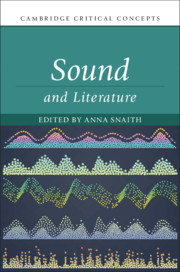Book contents
- Sound and Literature
- Cambridge Critical Concepts
- Sound and Literature
- Copyright page
- Epigraph
- Contents
- Figures
- Contributors
- Acknowledgements
- Introduction
- Part I Origins
- Chapter 1 Hearing and the Senses
- Chapter 2 Fragments on/of Voice
- Chapter 3 Sonic Forms
- Chapter 4 Classical Music and Literature
- Chapter 5 Aesthetics, Music, Noise
- Part II Development
- Part III Applications
- Bibliography
- Index
Chapter 4 - Classical Music and Literature
from Part I - Origins
Published online by Cambridge University Press: 29 May 2020
- Sound and Literature
- Cambridge Critical Concepts
- Sound and Literature
- Copyright page
- Epigraph
- Contents
- Figures
- Contributors
- Acknowledgements
- Introduction
- Part I Origins
- Chapter 1 Hearing and the Senses
- Chapter 2 Fragments on/of Voice
- Chapter 3 Sonic Forms
- Chapter 4 Classical Music and Literature
- Chapter 5 Aesthetics, Music, Noise
- Part II Development
- Part III Applications
- Bibliography
- Index
Summary
In Western literature music functions ‘as the vehicle for everything that cannot be represented or denoted.’ Anglophone literature of the nineteenth and twentieth centuries works with a specific musical tradition that we broadly term ‘classical music’ which encompasses a set of intellectual, aesthetic, historical and cultural ideas. From Wagner’s Total Art-Work to Walter Pater’s claims about music as the ‘consummate’ art form, classical music as an aesthetic paradigm has not just offered literature a set of cultural reference points, but philosophical and intellectual traditions that shape its aesthetic experiments and styles. Nowhere is the idea of music more fully delineated by a composer than in the work of Wagner, and his music has had perhaps the greatest influence on literature. Wagner provides a focal point for discussions of classical music in literature in this chapter, especially around the role of the Gesamtkunstwerk in Virginia Woolf’s negotiations with aesthetics and the artwork. Laura Marcus has argued that literary modernism took on filmic devices. This chapter argues that it did the same with music. Newly conscious of forms, languages, systems and somatic effects, modernist writers turned to music and particularly Wagner as a paradigm of artistic expression.
- Type
- Chapter
- Information
- Sound and Literature , pp. 92 - 113Publisher: Cambridge University PressPrint publication year: 2020

